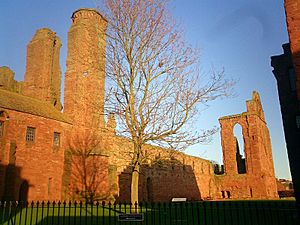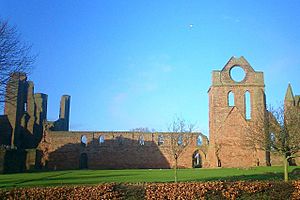Arbroath Abbey facts for kids
Quick facts for kids Arbroath Abbey |
|
|---|---|
 |
|
| 56°33′45″N 2°34′56″W / 56.5625°N 2.582222°W | |
| History | |
| Founded | 1178 |
| Founder(s) | King William the Lion |
Arbroath Abbey is a famous old building in the Scottish town of Arbroath. It was started in 1178 by King William the Lion. He built it for a group of Benedictine monks from Kelso Abbey.
The Abbey was officially opened in 1197. It was dedicated to Saint Thomas Becket, a saint the king had met. King William was buried at the Abbey in 1214.
The last leader of the Abbey was Cardinal David Beaton. Today, Historic Environment Scotland looks after the Abbey. You can visit the ruins all year round. The Abbey is made of red sandstone and stands at the top of Arbroath's High Street.
History of Arbroath Abbey
How the Abbey Grew and Became Rich

King William made Arbroath Abbey independent from its first home, Kelso Abbey. He also gave it lots of money and land. This included money from 24 church areas and land in every royal town.
The monks at the Abbey could even run a market and build a harbour. King John of England allowed the Abbey to buy and sell things anywhere in England without paying extra taxes. This made Arbroath Abbey the richest Abbey in Scotland.
The Famous Declaration of Arbroath
The Abbey is most famous for something very important that happened there in 1320. This was the Declaration of Scottish Independence. It was a letter asking the Pope to recognize Scotland as a free country.
Many people believe that Abbot Bernard of Kilwinning wrote this important letter. He was a top advisor to King Robert I.
What Happened After the Reformation
After the Scottish Reformation, the Abbey started to fall apart. From 1590, people in Arbroath began taking stones from the Abbey to build their own houses. This continued until 1815, when people decided to protect what was left of the ruins.
The Mystery of the Stone of Destiny
On Christmas Day in 1950, the famous Stone of Destiny went missing from Westminster Abbey in England. This stone is very important to Scottish history. On April 11, 1951, the missing stone was found right where the Abbey's altar used to be!
Celebrating History at the Abbey
Since 1947, there have been big historical shows at the Abbey. These shows remember the signing of the Declaration of Arbroath. A local group, the Arbroath Abbey Pageant Society, puts on these events. They tell the story of how the Declaration came to be.
Even though the big show isn't every year, a special event happens every April 6th. This includes a parade and a short play in the street.
Working for World Heritage Status
In 2005, a group started the Arbroath Abbey campaign. They want the Abbey to become a World Heritage Site. This means it would be recognized by the United Nations as a very important place for everyone in the world.
People involved in the campaign believe the Declaration of Arbroath makes the Abbey a perfect choice. They say the Declaration is a very important piece of writing. In 2008, the campaign leader, Councillor Jim Millar, asked people to sign a petition. He said, "We're simply asking people... to sign up to the campaign to have the Declaration of Arbroath and Arbroath Abbey recognized by the United Nations."
Architecture of Arbroath Abbey
How the Abbey Was Built
The Abbey took about sixty years to build. It was made using local red sandstone. Even though it took a long time, it looks like it was all designed at once. It has an "Early English" style.
The church was shaped like a cross. It was about 276 feet (84 meters) long and 160 feet (49 meters) wide. Today, parts that are still standing include the sacristy (a room for church items) and the southern transept (the arm of the cross shape). This transept has Scotland's largest lancet windows (tall, narrow windows). You can also see parts of the choir (where the monks sang) and the nave (the main part of the church).
The church used to have a tall central tower and probably a spire. These would have been seen for miles around, even by ships at sea. The soft sandstone walls were once covered with plaster to protect them. This plaster is now gone, so some of the detailed carvings have worn away.
The Famous Round 'O'
The special round window high up in the south transept was once lit up at night. It acted like a beacon for sailors. People in Arbroath call this window the 'Round O'. Because of this, people from Arbroath are sometimes called 'Reid Lichties', which means 'Red Lighters' in Scots.
Other Abbey Buildings
Not much is left of the other buildings where the monks lived. But there is an impressive gatehouse. It connects the church to a defensive tower on the High Street. The Abbot's House is also still standing. It was built over many years and is the best-preserved house of its kind in Scotland.

In 2001, a new visitor center opened next to the Abbey. This building is also made of red sandstone. It has a unique 'wave-shaped' roof. Inside, you can see displays about the Abbey's history and some of its best stone carvings.
Upstairs, there's a model of the Abbey and a computer animation. This animation shows what the church looked like when it was complete. There's also a viewing area with great views of the ruins. Before the center was built, archaeologists found old walls and discarded stone. This showed that the area was once where the Abbey's builders worked.
See also
 In Spanish: Abadía de Arbroath para niños
In Spanish: Abadía de Arbroath para niños



